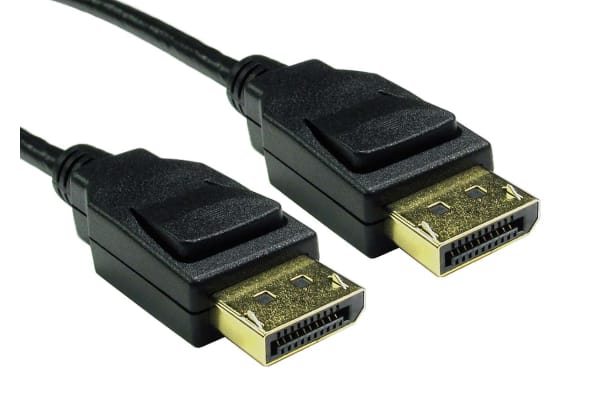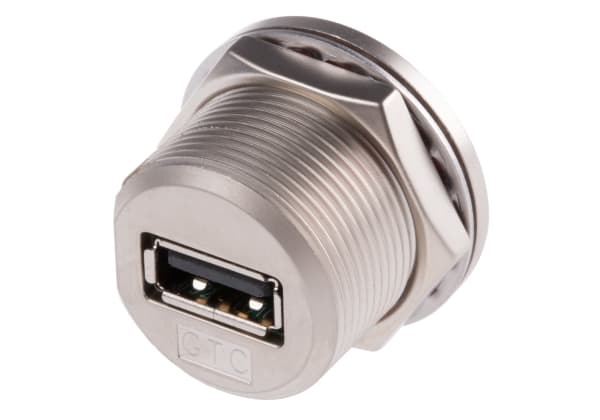- Published 29 Aug 2024
- Last Modified 29 Aug 2024
- 8 min
Understanding Thunderbolt Cables
Thunderbolt cable connections look similar to other types, but how do they compare in performance? Learn here what the Thunderbolt designations include and how they compare to and work with other connection types.
Reviewed by Peter Kendall, Technical Interaction Engineer (August, 2024)
Thunderbolt cables and their ports have been rising to prominence in recent years, sharing more and more of the market with USB connections. But just what is a Thunderbolt cable? What advantages does it offer?
This guide will explain what Thunderbolt cables do, how they compare to other computer cables and connection types, and how to use a Thunderbolt cable. These cables bring many advantages to home and office computing, especially for the monitors they support.
What is a Thunderbolt Cable?
Thunderbolt cables collect multiple functionalities into one cable. They handle data transfer, power supply, and video output; they support multiple devices and protocols; and they do all this with high performance.
Apple and Intel developed the various generations of Thunderbolt cables for connections between computers, display monitors, and other desktop computing productivity devices. Thunderbolt is a trademarked name, and Apple and Intel continue to develop new generations for it.
But what is a Thunderbolt port? To deliver their advantages, Thunderbolt cables must connect to equally specialised ports on devices. Look for the symbol of a lightning bolt with an arrowhead, often accompanied by a number indicating the Thunderbolt generation.
What Thunderbolt Cables Do
So, what is a Thunderbolt cable used for? Thunderbolt cables and ports can handle all the following functionalities at high data-transfer speeds:
- Connect computers to display monitors, especially laptops to 4K and 8K monitors.
- Receive inputs from keyboards, mice, and gaming controllers (often using wireless adaptors).
- Manage video signals for up to five devices.
- Supply charging power to connected devices.
- Adapt to and support handling signals from USB, HDMI, Lightning, DisplayPort, Mini DisplayPort, and FireWire connections.
- ‘Daisy chain’ Thunderbolt-capable devices: For example, connect a laptop, a video capture card, an external hard drive, and two monitors, all in a single chain of Thunderbolt cable connections — with all devices supported and working together.
Thunderbolt cables give you improved performance and a less cluttered workspace since they combine so many functions into a single cable.
Thunderbolt Cable Requirements
Thunderbolt 3 and 4 cables (the generations used today) differ not only in their bandwidth but in the devices they must support, and any manufacturer marketing devices as Thunderbolt 3 or 4 must meet Intel’s requirements for those.
- Both provide 15 to 100W of charging power.
- Both have a total bandwidth of 40 Gbps, but Thunderbolt 4’s minimum data transfer speed is 32 Gbps: double that of Thunderbolt 3.
- Thunderbolt 3 only supports one 4K monitor, while Thunderbolt 4 supports two (or one 8K monitor).
- Thunderbolt 4 requires simple key or mouse strokes to wake up a sleeping computer, something Thunderbolt 3 sorely lacked.
- Thunderbolt 4 has improved protection from direct memory access (DMA) attacks (security breaches from malicious devices plugged into a device’s port).
All these differences significantly affect the experience of using personal computers, especially for connecting laptops to high-performance monitors.
Thunderbolt Cable Types
Which Thunderbolt cable do I need?
Thunderbolt cable has experienced five generations. Thunderbolts 1 and 2 debuted in 2011 and 2013, respectively, and they both used the Mini DisplayPort, as used to be seen on all Apple computers. As Apple has superseded that type of port, Thunderbolts 1 and 2 are effectively obsolete these days.
Thunderbolts 3 and 4 came out in 2015 and 2020, respectively, and are in active use in many devices today.
What does a Thunderbolt cable look like? Thunderbolts 3 and 4 both share the symmetric, oval, 24-interior-pin physical connection type with USB-C, though their performance characteristics differ, as described above. Thunderbolt cables should also have the arrowed lightning symbol identifying them.
Can you tell Thunderbolts 3 and 4 apart? Only if the cables or ports have labels with those numbers. Thunderbolt cables often have an identifying 3 or 4, but ports may not. Consult your device’s documents to be sure of your ports’ capabilities.
Thunderbolt 5 is coming out in 2024 and promises to further increase the bandwidth and charging power of Thunderbolt technology.
Comparing Thunderbolts to Other Cables
How do Thunderbolt cables compare to the other various types of cables we encounter every day with our devices? They measure up quite well, though devices may not always have the right Thunderbolt ports for enabling these cables’ full potential.
Thunderbolt vs HDMI
HDMI cables and ports are ubiquitous in home theatre devices, and are still a solid choice in that field. The new HDMI 2.1 standard, which improves performance for 8K resolution and beyond, continues to keep HDMI relevant.
When it comes to Thunderbolt vs HDMI, though, Thunderbolt is the superior choice for connecting computers to monitors. If you have Thunderbolt ports available on your workstation’s devices, choose them over HDMI.
While they both can handle audio and video signals at high bandwidth, HDMI has limited charging functionality and poor charging performance, and it can only handle data transfer through the HDMI types that support ethernet. Also, HDMI daisy chaining supports only multiple monitors and not other productivity devices, and even this requires adaptors and splitters.
Thunderbolt vs USB
Thunderbolt’s most comparable version of the USB (Universal Series Bus) standard is USB4, which uses USB-C connections. There are no physical connection differences in Thunderbolt vs USB-C, other than the symbols and numbers labelling them.
USB4 sports many of Thunderbolt 4’s capabilities, such as 40 Gbps speeds — but only for cable lengths up to 1 metre, while Thunderbolt 4 can do 2 metres. USB4 has decent charging ability, though only 7.5W compared to Thunderbolt 4’s 15W. USB4 can also handle 8K video, but it can’t support multiple 4K monitors like Thunderbolt 4 can.
Thunderbolt also has stringent requirements that devices must meet for Intel to allow use of the Thunderbolt designation. This makes devices more expensive, but that comes with a greater guarantee of quality. For this reason, USB cables supporting USB4 may be the better choice if you don’t need high-cost, high-performing gear.
Thunderbolt vs Lightning
Despite their confusingly similar names, Thunderbolt and Lightning connections are not the same. Lightning is a proprietary Apple connection used for slightly older generations of its mobile devices like iPhones and iPads. Lightning cable connections are reversible, like with Thunderbolt, and their 8 pins are distinguishingly visible on their exteriors.
Broadly speaking, Lightning was for Apple’s older handheld mobile devices while Thunderbolt is for computer workstations and appears on non-Apple products. Lightning isn’t meant for the high-performance data transfer or multiple device support that Thunderbolt has.
Newer Apple mobile devices use USB-C, letting them more easily connect to Thunderbolt ports. If you need to connect a Lightning device to a Thunderbolt port for charging or data transfer, use a Lightning to USB-C adapting cable.
Using Thunderbolt Cables
Using Thunderbolt cables for your workstation can boost your productivity and unlock many quality-of-life benefits.
Thunderbolt Cable Advantages
With Thunderbolt cables connecting your computer, monitors, and other productivity devices you can:
- Transfer large files faster with Thunderbolt speeds of 40 Gbps.
- Rely on a single cable for charging, data transfer, and audio-video signals.
- Have less cable clutter due to daisy chaining your devices.
- Enjoy 4K and 8K video resolution for your in-office work while keeping your computer mobile for other business needs.
- Plug in your laptop after a day on the go and immediately get both fast charging and data transfer.
- Use Thunderbolt ports as all-purpose access points for devices, provided you have the right adaptors.
- Rest easy due to these ports’ protection against DMA attacks.
- Never worry about getting the orientation wrong when connecting a cable.
Thunderbolt Adaptors
If you need to connect something that can’t fit in a Thunderbolt 3 or 4 port, adaptors exist to help you out:
- Thunderbolt to USB adaptors let you work with the many other USB types out there, especially the classic (but now demonstrably supplanted) USB Type A.
- Thunderbolt to HDMI adaptors help connect newer laptops to monitors that only have HDMI ports.
- Thunderbolt to DisplayPort adaptors cover this other common monitor port. Adaptors also exist for Mini DisplayPort, seen on older Apple devices, and for the similar Thunderbolts 1 and 2.
- Thunderbolt to Firewire adaptors let you keep working with older external hard drives and digital cameras that use Firewire connections.
- USB-C to Lightning adaptors let you connect slightly older Apple mobile devices to Thunderbolt ports.
Keep in mind that these adaptors don’t automatically give Thunderbolt benefits to these non-Thunderbolt devices. You’ll typically just retain each older type’s capabilities and deliver them via a Thunderbolt port.
RS carries adaptors and cables to help you make any connections you need. Browse our data transfer products today.



